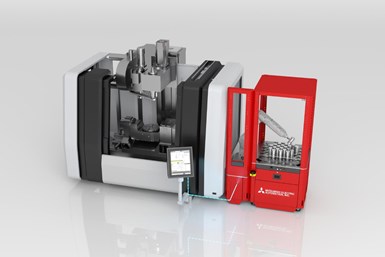Mitsubishi Automation Solution Provides Flexible Machine Tending
Mitsubishi Electric’s machine tending solutions help alleviate labor shortage challenges while improving productivity and lowering operating costs.
Share





Mitsubishi Electric Automation Inc.’s LoadMate Plus product line is a machine tending solution designed to be easy to implement while offering flexibility and mobility to address ongoing labor shortage challenges.
Through flexible connectivity via Ethernet and easy programming through the direct robot control (DRC) feature of Mitsubishi Electric’s M8 Series, machine tending can benefit customers that may not have experienced robot programmers available. In addition to DRC, almost any CNC machine can be connected to a shop floor via discrete I/O for non-M8 CNC controls from Mitsubishi Electric and other companies. Further support is available through Mitsubishi Electric trained engineers to service both robot and CNC. Additionally, Mitsubishi Electric Automation offers a five-year robot maintenance and warranty program.
“Mitsubishi Electric Automation Inc.’s machine tending solutions portfolio
provides a cost-effective answer to ongoing labor shortages and
maximized productivity challenges many manufacturers are currently
experiencing. Our experts work closely with your team to find and implement a turn-key solution that is seamlessly integrated, fully supported
and delivers ROI quickly” says Dave Simak, service product manager at
Mitsubishi Electric Automation Inc.
Related Content
-
Translating a Prototyping Mindset to Production
The experimental mindset that benefited BDE Manufacturing Technologies as a prototype job shop has given it an adaptable edge as a production facility.
-
Managing Coolant with Skimmers, Refractometers and More
Bacteria-infected coolant harms machines and sickens machinists. Coolant management technologies like skimmers and automated systems counter this tendency.
-
Lean Approach to Automated Machine Tending Delivers Quicker Paths to Success
Almost any shop can automate at least some of its production, even in low-volume, high-mix applications. The key to getting started is finding the simplest solutions that fit your requirements. It helps to work with an automation partner that understands your needs.






















